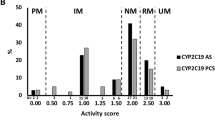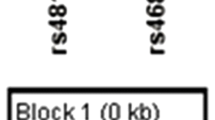Abstract
The widely used antipsychotic drug, olanzapine (OLA) shows large interindividual variability in metabolic clearance. Although the role of the enzymes CYP1A2, CYP2D6 and UGT1A4 has been extensively explored, little is known about the in vivo role of flavin-containing monooxygenases (FMOs) catalyzing the N-oxidation of OLA in vitro. We investigated the influence of FMO1 and 3 polymorphisms on the steady state serum concentrations of OLA and its N-oxide metabolite in 379 patients. The upstream FMO1*6 was associated with increased dose-adjusted serum OLA concentrations (C/Ds; P=0.008), an effect further enhanced by FMO1rs7877C>T in smokers. The influence of FMO3 polymorphisms was limited to variability in OLA N-oxide. Homozygous carriers of FMO3rs2266780A>G (p.E308G) displayed 50% lower C/D of OLA N-oxide compared with subjects homo- or heterozygous for the A-variant (P<0.003). Our data support the role of FMO3 in the N-oxidation of OLA and implicate for the first time the contribution of FMO1 and its functional *6 variant in OLA disposition.
This is a preview of subscription content, access via your institution
Access options
Subscribe to this journal
Receive 6 print issues and online access
$259.00 per year
only $43.17 per issue
Buy this article
- Purchase on Springer Link
- Instant access to full article PDF
Prices may be subject to local taxes which are calculated during checkout


Similar content being viewed by others
References
Lieberman JA, Stroup TS, McEvoy JP, Swartz MS, Rosenheck RA, Perkins DO et al. Effectiveness of antipsychotic drugs in patients with chronic schizophrenia. N Engl J Med 2005; 353: 1209–1223.
Citrome L . A systematic review of meta-analyses of the efficacy of oral atypical antipsychotics for the treatment of adult patients with schizophrenia. Expert Opin Pharmacother 2011; 13: 1545–1573.
Perry PJ, Argo TR, Carnahan RM, Lund BC, Holman TL, Ellingrod VL et al. The association of weight gain and olanzapine plasma concentrations. J Clin Psychopharmacol 2005; 25: 250–254.
Melkersson KI, Dahl ML . Relationship between levels of insulin or triglycerides and serum concentrations of the atypical antipsychotics clozapine and olanzapine in patients on treatment with therapeutic doses. Psychopharmacology (Berl) 2003; 170: 157–166.
Perry PJ, Lund BC, Sanger T, Beasley C . Olanzapine plasma concentrations and clinical response: acute phase results of the North American Olanzapine Trial. J Clin Psychopharmacol 2001; 21: 14–20.
Hiemke C, Baumann P, Bergemann N, Conca A, Dietmaier O, Egberts K et al. AGNP consensus guidelines for therapeutic drug monitoring in psychiatry: update 2011. Pharmacopsychiatry 2011; 44: 195–235.
Skogh E, Reis M, Dahl ML, Lundmark J, Bengtsson F . Therapeutic drug monitoring data on olanzapine and its N-demethyl metabolite in the naturalistic clinical setting. Ther Drug Monit 2002; 24: 518–526.
Patel MX, Bowskill S, Couchman L, Lay V, Taylor D, Spencer EP et al. Plasma olanzapine in relation to prescribed dose and other factors data from a therapeutic drug monitoring service, 1999-2009. J Clin Psychopharmacol 2011; 31: 411–417.
Gex-Fabry M, Balant-Gorgia AE, Balant LP . Therapeutic drug monitoring of olanzapine: The combined effect of age, gender, smoking, and comedication. Ther Drug Monit 2003; 25: 46–53.
Olesen OV, Linnet K . Olanzapine serum concentrations in psychiatric patients given standard doses: the influence of comedication. Ther Drug Monit 1999; 21: 87–90.
Bergemann N, Kress KR, Abu-Tair F, Frick A, Kopitz J . Valproate lowers plasma concentration of olanzapine. J Clin Psychopharmacol 2006; 26: 432–434.
Spina E, DArrigo C, Santoro V, Muscatello MR, Pandolfo G, Zoccali R et al. Effect of valproate on olanzapine plasma concentrations in patients with bipolar or schizoaffective disorder. Ther Drug Monit 2009; 31: 758–763.
Skogh E, Sjodin I, Josefsson M, Dahl ML . High correlation between serum and cerebrospinal fluid olanzapine concentrations in patients with schizophrenia or schizoaffective disorder medicating with oral olanzapine as the only antipsychotic drug. J Clin Psychopharmacol 2011; 31: 4–9.
Linnet K . Glucuronidation of olanzapine by cDNA-expressed human UDP-glucuronosyltransferases and human liver microsomes. Hum Psychopharmacol 2002; 17: 233–238.
Ring BJ, Catlow J, Lindsay TJ, Gillespie T, Roskos LK, Cerimele BJ et al. Identification of the human cytochromes P450 responsible for the in vitro formation of the major oxidative metabolites of the antipsychotic agent olanzapine. J Pharmacol Exp Ther 1996; 276: 658–666.
Kassahun K, Mattiuz E, Nyhart E, Obermeyer B, Gillespie T, Murphy A et al. Disposition and biotransformation of the antipsychotic agent olanzapine in humans. Drug Metab Dispos 1997; 25: 81–93.
Callaghan JT, Bergstrom RF, Ptak LR, Beasley CM . Olanzapine. Pharmacokinetic and pharmacodynamic profile. Clin Pharmacokinet 1999; 37: 177–193.
Ghotbi R, Mannheimer B, Aklillu E, Suda A, Bertilsson L, Eliasson E et al. Carriers of the UGT1A4 142 T>G gene variant are predisposed to reduced olanzapine exposure—an impact similar to male gender or smoking in schizophrenic patients. Eur J Clin Pharmacol 2010; 66: 465–474.
Laika B, Leucht S, Heres S, Schneider H, Steimer W . Pharmacogenetics and olanzapine treatment: CYP1A2*1F and serotonergic polymorphisms influence therapeutic outcome. Pharmacogenomics J 2010; 10: 20–29.
Carrillo JA, Herraiz AG, Ramos SI, Gervasini G, Vizcaino S, Benitez J . Role of the smoking-induced cytochrome P450 (CYP)1A2 and polymorphic CYP2D6 in steady-state concentration of olanzapine. J Clin Psychopharmacol 2003; 23: 119–127.
Mao M, Skogh E, Scordo MG, Dahl M . Interindividual variation in olanzapine concentration influenced by UGT1A4 L48V polymorphism in serum and upstream FMO polymorphisms in cerebrospinal fluid. J Clin Psychopharmacol 2012; 32: 287–289.
Hägg S, Spigset O, Lakso HA, Dahlqvist R . Olanzapine disposition in humans is unrelated to CYP1A2 and CYP2D6 phenotypes. Eur J Clin Pharmacol 2001; 57: 493–497.
Bigos KL, Bies RR, Pollock BG, Lowy JJ, Zhang F, Weinberger DR . Genetic variation in CYP3A43 explains racial difference in olanzapine clearance. Mol Psychiatry 2011; 16: 620–625.
Bickel MH . The pharmacology and biochemistry of N-oxides. Pharmacol Rev 1969; 21: 325–355.
Bickel MH . Liver metabolic reactions: Tertiary amine N-dealkylation, tertiary amine N-oxidation, N-oxide reduction, and N-oxide N-dealkylation: I. Tricyclic tertiary amine drugs. Arch Biochem Biophys 1972; 148: 54–62.
Cashman JR . Structural and catalytic properties of the mammalian flavin-containing monooxygenase. Chem Res Toxicol 1995; 8: 166–181.
Overby LH, Carver GC, Philpot RM . Quantitation and kinetic properties of hepatic microsomal and recombinant flavin-containing monooxygenases 3 and 5 from humans. Chem Biol Interact 1997; 106: 29–45.
Yeung CK, Lang DH, Thummel KE, Rettie AE . Immunoquantitation of FMO1 in human liver, kidney, and intestine. Drug Metab Disposition 2000; 28: 1107–1111.
Bhagwat SV, Bhamre S, Boyd MR, Ravindranath V . Cerebral metabolism of imipramine and a purified flavin-containing monooxygenase from human brain. Neuropsychopharmacology 1996; 15: 133–142.
Nielsen SS, McKean-Cowdin R, Farin FM, Holly EA, Preston-Martin S, Mueller BA . Childhood brain tumors, residential insecticide exposure, and pesticide metabolism genes. Environ Health Perspect 2010; 118: 144–149.
Hinrichs AL, Murphy SE, Wang JC, Saccone S, Saccone N, Steinbach JH et al. Common polymorphisms in FMO1 are associated with nicotine dependence. Pharmacogenet Genomics 2011; 21: 397–402.
Koukouritaki SB, Hines RN . Flavin-containing monooxygenase genetic polymorphism: Impact on chemical metabolism and drug development. Pharmacogenomics 2005; 6: 807–822.
Haslemo T, Loryan I, Ueda N, Mannheimer B, Bertilsson L, Ingelman-Sundberg M et al. UGT1A4*3 encodes significantly increased glucuronidation of olanzapine in patients on maintenance treatment and in recombinant systems. Clin Pharmacol Ther 2012; 92: 221–227.
Fan JB, Oliphant A, Shen R, Kermani BG, Garcia F, Gunderson KL et al. Highly parallel SNP genotyping. Cold Spring Harb Symp Quant Biol 2003; 68: 69–78.
Hines RN, Luo Z, Hopp KA, Cabacungan ET, Koukouritaki SB, McCarver DG . Genetic variability at the human FMO1 locus: significance of a basal promoter yin yang 1 element polymorphism (FMO1*6). J Pharmacol Exp Ther 2003; 306: 1210–1218.
Lemoine A, Johann M, Cresteil T . Evidence for the presence of distinct flavin-containing monooxygenases in human tissues. Arch Biochem Biophys 1990; 276: 336–342.
Novick RM, Mitzey AM, Brownfield MS, Elfarra AA . Differential localization of flavin-containing monooxygenase (FMO) isoforms 1, 3, and 4 in rat liver and kidney and evidence for expression of FMO4 in mouse, rat, and human liver and kidney microsomes. J Pharmacol Exp Ther 2009; 329: 1148–1155.
Parte P, Kupfer D . Oxidation of tamoxifen by human flavin-containing monooxygenase (FMO) 1 and FMO3 to tamoxifen-N-oxide and its novel reduction back to tamoxifen by human cytochromes P450 and hemoglobin. Drug Metab Disposition 2005; 33: 1446–1452.
Pirmohamed M, Williams D, Madden S, Templeton E, Park BK . Metabolism and bioactivation of clozapine by human liver in-vitro. J Pharmacol Exp Ther 1995; 272: 984–990.
Calligaro DO, Fairhurst J, Hotten TM, Moore NA, Tupper DE . The synthesis and biological activity of some known and putative metabolites of the atypical antipsychotic agent olanzapine (LY170053). Bioorg Med Chem Lett 1997; 7: 25–30.
Hernandez D, Janmohamed A, Chandan P, Omar BA, Phillips IR, Shephard EA . Deletion of the mouse Fmo1 gene results in enhanced pharmacological behavioural responses to imipramine. Pharmacogenet Genomics 2009; 19: 289–299.
Mao M, Matimba A, Scordo MG, Gunes A, Zengil H, Yasui-Furukori N et al. Flavin-containing monooxygenase 3 polymorphisms in 13 ethnic populations from Europe, East Asia and sub-Saharan Africa: frequency and linkage analysis. Pharmacogenomics 2009; 10: 1447–1455.
Park CS, Kang JH, Chung WG, Yi HG, Pie JE, Park DK et al. Ethnic differences in allelic frequency of two flavin-containing monooxygenase 3 (FMO3) polymorphisms: linkage and effects on in vivo and in vitro FMO activities. Pharmacogenetics 2002; 12: 77–80.
Hisamuddin IM, Wehbi MA, Schmotzer B, Easley KA, Hylind LM, Giardiello FM et al. Genetic polymorphisms of flavin monooxygenase 3 in sulindac-induced regression of colorectal adenomas in familial adenomatous polyposis. Cancer Epidemiol Biomarkers Prev 2005; 14: 2366–2369.
Phillips IR, Shephard EA . Flavin-containing monooxygenases: mutations, disease and drug response. Trends Pharmacol Sci 2008; 29: 294–301.
Nagashima S, Shimizu M, Yano H, Murayama N, Kumai T, Kobayashi S et al. Inter-individual variation in flavin-containing monooxygenase 3 in livers from Japanese: correlation with hepatic transcription factors. Drug Metab Pharmacokinet 2009; 24: 218–225.
Celius T, Pansoy A, Matthews J, Okey AB, Henderson MC, Krueger SK et al. Flavin-containing monooxygenase-3: induction by 3-methylcholanthrene and complex regulation by xenobiotic chemicals in hepatoma cells and mouse liver. Toxicol Appl Pharmacol 2010; 247: 60–69.
Nozawa M, Ohnuma T, Matsubara Y, Sakai Y, Hatano T, Hanzawa R et al. The relationship between the response of clinical symptoms and plasma olanzapine concentration, based on pharmacogenetics: Juntendo University Schizophrenia Projects (JUSP). Ther Drug Monit 2008; 30: 35–40.
Acknowledgements
We would like to thank Hilde Lunde at Center for Psychopharmacology Diakonhjemmet Hospital for assistance regarding re-analysis of OLA N-oxide concentrations in the TDM samples, Tomas Axelsson and the staff at The SNP&SEQ Technology Platform for their assistance with genotyping, and Maria Gabriella Scordo for helpful discussions on this manuscript.
Funding: The study was financially supported by the Swedish Research Council. The SNP&SEQ Technology Platform in Uppsala is supported by Uppsala University, Uppsala University hospital, the Swedish Council for Research Infrastructure and the Knut and Alice Wallenberg Foundation.
Author information
Authors and Affiliations
Corresponding author
Ethics declarations
Competing interests
The authors declare no conflict of interest.
Additional information
Supplementary Information accompanies the paper on the The Pharmacogenomics Journal website
Supplementary information
PowerPoint slides
Rights and permissions
About this article
Cite this article
Söderberg, M., Haslemo, T., Molden, E. et al. Influence of FMO1 and 3 polymorphisms on serum olanzapine and its N-oxide metabolite in psychiatric patients. Pharmacogenomics J 13, 544–550 (2013). https://doi.org/10.1038/tpj.2012.47
Received:
Revised:
Accepted:
Published:
Issue Date:
DOI: https://doi.org/10.1038/tpj.2012.47
Keywords
This article is cited by
-
CYP1A2 expression rather than genotype is associated with olanzapine concentration in psychiatric patients
Scientific Reports (2023)
-
Quantification of olanzapine and its three metabolites by liquid chromatography–tandem mass spectrometry in human body fluids obtained from four deceased, and confirmation of the reduction from olanzapine N-oxide to olanzapine in whole blood in vitro
Forensic Toxicology (2023)
-
Roles of selected non-P450 human oxidoreductase enzymes in protective and toxic effects of chemicals: review and compilation of reactions
Archives of Toxicology (2022)
-
The Impact of Smoking, Sex, Infection, and Comedication Administration on Oral Olanzapine: A Population Pharmacokinetic Model in Chinese Psychiatric Patients
European Journal of Drug Metabolism and Pharmacokinetics (2021)
-
Pharmacokinetics and pharmacogenomics of daunorubicin in children: a report from the Children’s Oncology Group
Cancer Chemotherapy and Pharmacology (2014)



